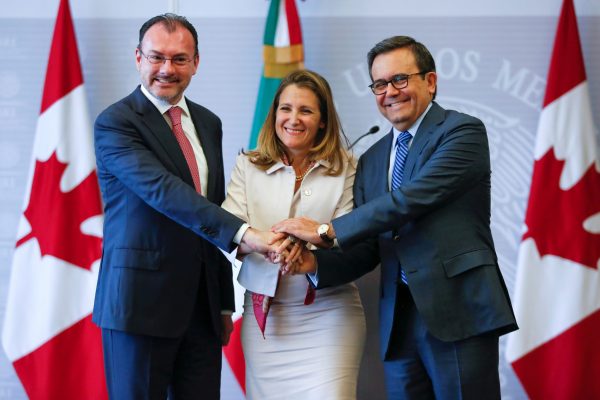For outgoing Mexican President Enrique Peña Nieto, the deal represented a significant achievement. It looked ‘impossible’ given Trump’s continuing threats and systematic bullying throughout the negotiations. Peña Nieto made significant concessions to cut this deal so he can sign it before he leaves office on 1 December. He used it from day one to mend his political image greatly damaged by the rampant impunity and corruption that plagued his administration.
The new president-elect, Andrés Manuel López Obrador, is pleased as well. Since he opposed NAFTA in the early 1990s when he was a rising social leader, it would be awkward for him, now as a leftist president, to sign another ‘neoliberal’ trade agreement. Fortunately for him, the main issues of interest to his government were treated favourably in the negotiations.
In particular, he is satisfied that under the new deal Mexico retains its sovereignty to pass reforms in the energy sector and thus implement policies to expand oil exploration, extraction and processing to produce gasoline domestically. The fact, though, is that this sovereignty was never subject to negotiation.
The logic that prevailed was that it is better for Mexico to strike a suboptimal deal rather than do business with the world’s largest economy without any rules and with some degree of certainty. The problem is that such a deal has many downsides.
One is that it was negotiated largely without the participation of Canada so that Mexico ceded upfront to Trump’s declared intention of abolishing NAFTA. Another is that Mexican negotiators were incapable of eliminating the so-called ‘sunset’ clause through which Trump originally intended that the agreement expired every five years. In the new deal, the clause was only modified by extending the timeframe to 16 years, with revisions every six.
Mexico also accepted huge concessions in the automotive sector. The regional content requirement for the products of this sector will jump from 62.5 to 75 per cent. If this percentage is not met, a 2.5 per cent tariff will apply. In some cases, wages will also be forced to sharply increase up to US$16 per hour from an average of US$2.50. In these cases, the regional content requirement will be of only 40 to 45 per cent of the total value of vehicles.
On top of all that, Mexico agreed that the United States can invoke Section 232 of the Trade Expansion Act of 1962 to impose, in the interest of national security, a 25 per cent tariff on imports of light vehicles, SUVs and auto parts produced in Mexico when they exceed 2.4 million vehicles and US$90 billion in auto parts.
Even worse, Mexico accepted the elimination of the dispute settlement panels stipulated in Annex 1901.2 of NAFTA — only those to resolve controversies in matters related to oil, gas and infrastructure were retained.
In sum, Mexico lost and Trump won. He simultaneously killed NAFTA, as he threatened since he took office, and honoured his campaign promise to bring back jobs to the United States. The agreed increase in wages in the Mexican auto industry enables jobs that migrated south under NAFTA to move back north across the Rio Grande.
Fortunately for Mexico, Canada struck a last-minute deal with the United States on 30 September after Ottawa agreed to partially open its dairy market to imports from the United States and Mexico. In this way, Canada joined these trading partners into what was oddly called United States–Mexico–Canada Agreement (USMCA). This new deal, whose name lacks any reference to free trade, keeps NAFTA’s trilateral character but also secures Trump’s interests and goals. Mexico will benefit greatly from what Canada was able to achieve in its negotiations with the United States, mainly the preservation of the dispute resolution panels stipulated in NAFTA’s chapters 19 and 20, now specified in Chapter 31 of the USMCA.
It is expected that this new North American agreement will be signed by the end of November by the respective heads of government. But it is not certain that the US Congress will ratify it outright given the high prospects for the Democrats to regain majority in the mid-term elections earlier that month.
In any case, Trump wins again. The USMCA and the bogus US–Mexico agreement reached in August erode the ingredients of free trade contained in NAFTA and give way to the consolidation of managed trade. This new continental deal deepens what occurred in the revision of the South Korea–US trade agreement earlier this year and shows that, in practice, international trade is delimited, conditioned and, worse, subjected to the will of the leader of the dominant participating country. Alas, the tariffs imposed earlier by Trump on Mexican and Canadian steel and aluminium will remain, the USMCA notwithstanding.
Since the 1980s, managed trade was justified as a response to Japan’s consistent trade surpluses which resulted from the systematic management of its own trade. But the perils of this practice were also clear since then. The USMCA patently shows that managed trade is a renewed reality in a growingly protectionist world.
Juan J Palacios is a researcher at the Centre for Strategic Development Studies, University of Guadalajara, Mexico, and a member of the PAFTAD International Steering Committee.

